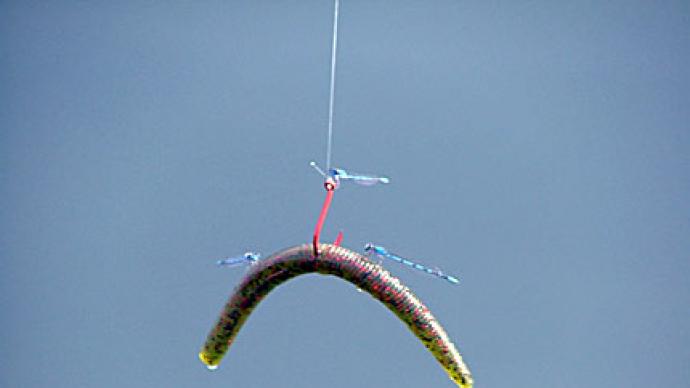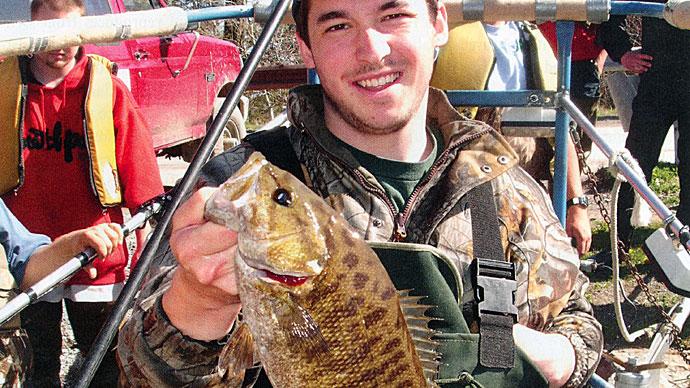I have lived and fished in Rhode Island for over 15 years and discovered some excellent bass fishing. On a typical mid-summer morning, I can land three fish over five pounds and as many as twenty in the two- to five-pound range. I have caught several over seven pounds, but they are rare in the small Rhode Island ponds. Learning how to catch these fish has not come easily. I've discovered how to catch big fish through an extensive trial and error period, probably about five years, to find the best combination.
Rhode Island waters are typically very brown from tannic acid and, throughout the summer, become thick with weeds that cover most of the rock formations. Visibility usually is about two to three feet in the ponds that don't allow motors and only six inches when there is a lot of boat traffic. The water depth in most ponds extends down to about twenty feet.

When I began fishing plastic worms, I used the Texas rig or the Carolina rig and ended up with many weeds stuck to the weight or the terminal tackle. After many hang-ups, snags, and mangled hooks, I discovered that fishing a plastic worm without weights worked best. This rig is terribly simple and very effective. The worm takes a few seconds to hit bottom, but the wait is almost always worthwhile.
The weightless Texas-rigged worm slides through the grass and weeds, and when fish pick it up, there is always a noticeable bump or change in line tightness. After that, the fish seem to hang on to the worm a little bit longer, and in many cases, they swallow it.
In contrast, a weighted Texas or Carolina rigged worm offered less reaction time. The reason for this is that the bass tend to ambush their prey. They suck it into their mouth and then swim back to their ambush spot to eat it and wait for another opportunity to feed. To the bass, the weighted bait must seem unnatural and is more readily spit out. The weightless worm combined with the salt in the bait must seem more realistic.
In the spring, the fish are in the shallows getting warm, and soon after they come off the spawning beds, they move into six to twelve feet of water. My approach throughout the year is the same.
I cast and let the worm sink to the bottom, then lay the rod down, leaving the bail open. It takes a few seconds, so I'll have a sip of coffee and enjoy the surroundings. Then watch the line to tighten and feed off the open bail. When the fish picks up the worm, it will tend to run a few feet and stop. Carefully, I'll close the bail, take up the slack, and set the hook like I'm ripping the lips off. Most of the time, I'm rewarded with a nice fight and a healthy bass. Sometimes, I'm rewarded with a pickerel or, other times, just half a worm.
The tackle I use is vital. Depending on the wind conditions, I use a 1/0 or 2/0 EWG Gamakatsu hook. I'll cover that later on. I prefer to use 8-pound Berkley XL because it has quite a bit of strength and the extra limp seems to have less memory and lays pretty flat on the water. Next are Zoom plastic worms. My three favorites are the 6-inch Junebug Ultravibe Speedworm, the 4-inch green ringworm, and the 6 3/4-inch pumpkin U Tail Worm. The Zoom worms are the toughest worms I've found. I can fish one worm for several fish before changing the worm. The Berkley power worms work well, but they are so soft that they must be changed after one hit or one fish. Maybe I'm just cheap, but I'd rather catch four fish per worm than only one fish.
I use two rods most of the time. Both are about seven feet long. One is medium heavy, in case I want to throw a Cotton Cordell Red Fin or a spinnerbait, and the other is medium light. I currently have Bass Pro Shops spinning reels with long cast spools. I like the rear drag if I hook a big fish and need to back off. The rods with the blank running through the handle give me the sensitivity I need when the fish are hitting light. I fish both rods at the same time. I can use one rod with Junebug and the other with Green. Many times I end up throwing one line out and very slowly retrieving the other line. Then I keep alternating rods and catching fish.
I have also discovered that the hook I use depends on the wind conditions. I use the Gamakatsu hook, which is very light when there is very little wind. However, the weight of the hook is essential because you want the worm to dance on top of the weeds and grass, not get buried in them.

If the wind blows over 10 knots, I shift to a heavier hook, such as a Gamakatsu Super Line hook. The added weight allows the worm to sink to the same grass region when the wind blows. Occasionally, when the wind gets going, I may add the smallest split shot I can find right to the line at the end of the worm.
Many people will leave the pond when the wind starts blowing, but I will use the wind to my advantage. I use a plastic bottle filled with gravel as an anchor and allow the wind to push the boat around. The plastic bottle slides across the bottom a little bit, allowing me to drift very slowly. Additionally, the wind can be used to aid in casting for distance.
With a very long cast, you present more opportunities for the bass to feed, maybe presenting the worm to several different fish over the 20- to 40-foot distance. Sometimes, a fish will hit right away, and they'll follow it up to the boat and pound it right as it lifts off the bottom.
My fishing buddy (Tom) has adopted my style and achieved the same results. I must credit him for discovering the heavy hook in the high-wind approach. He just happened to be using a heavy hook, and I was using a light hook. He caught about a dozen fish to my one for about an hour. As soon as I shifted to a heavy hook, I started catching as many fish as he did.

Tom also perfected the use of the Zoom Salty Fluke minnow. This is rigged, just like the plastic worm. It can be thrown into very heavy cover and remains weedless.
The key to fishing the Salty Fluke is to use it like a very slow twitch bait. You must use the rod tip to cause the bait to twitch and dart. Most of the hits on this bait are just as you twitch it or after the drop. I have noticed that unlike the worm hits, the minnow hits are far more savage. I assume this is because, in nature, the minnows are faster than worms, and the bass know this.
The weightless worm approach is especially effective in the early morning and the evening. During the middle of the day, I have to work like everyone else and throw spinners, jigs and stick baits.
Regardless of what part of the country you live in, you can try this technique. If you live in the south, where the bass tend to run larger, you should use a heavier line and a larger worm. If you catch a lot of weeds and snags with your Texas or Carolina rig, you should shift to the weightless worm and see if it works for you.
Thanks, and Good Fishing!
BassResource may receive a portion of revenues if you make a purchase using a link above.




